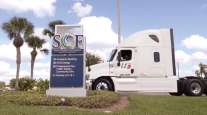FMCSA’s Earl Adams Stresses Collaboration for Driverless Technology

[Stay on top of transportation news: Get TTNews in your inbox.]
ORLANDO, Fla. — Government and industry collaboration is vital in terms of deploying emerging technologies such as autonomous trucks.
Earl Adams Jr., the newly appointed deputy administrator of the Federal Motor Carrier Safety Administration, offered that insight Feb. 28 at the Technology & Maintenance Council Annual Meeting and Transportation Technology Exhibition.
“The ability to use innovation and technology to achieve safety outcomes is something that we know is possible,” Adams said. “We, as an administration, are very much leaning forward in trying to work with industry on how we can integrate and deploy these new technologies.”
Advanced Driver Assistance Systems (ADAS) and Automated Driving Systems (ADS) are helping to reduce how much a truck driver has to do while behind the wheel. ADS systems could even remove the need for truck drivers in certain applications. Adams believes safety should be at the forefront in determining how they should be deployed and regulated.
“I’m actually very thankful to many of you who are sitting in the audience that I’ve had conversations with around how you all are getting on board and helping us achieve our zero-fatality goal around the National Roadway Safety Plan,” Adams said. “Specifically on ADS, I personally think that we as an administration have done a great deal in this area.”
This morning Earl Adams, Jr. was sworn in as Deputy Administrator of FMCSA. Read more at https://t.co/mnnVHlbMqS. Please join us in welcoming him! pic.twitter.com/YTkZRBPrrZ — FMCSA (@FMCSA) February 27, 2023
FMCSA started re-evaluating driverless regulations when it issued a supplemental notice of proposed rulemaking Feb. 1. The notice will allow industries and other stakeholders to share their perspectives on how regulations should look.
“This is a follow-up from the [Advanced Notice of Proposed Rule Making] that we published in 2019,” Adams said. “What we realized is that there was a lot of time that had transpired since the original APRM was actually published. And we felt that it was important that we go back out and seek public comment about evolutions and trends in the industry.”

Host Seth Clevenger chats with Evan Shelley, co-founder and CEO of TruckParkingClub. Hear the program above and at RoadSigns.TTNews.com.
Adams is optimistic the eventual updated rules will be more robust and effective between the new information gained from the supplemental notice combined with the information gained from the original notice in 2019.
“At the same time, I will tell you, it is going to be an iterative process,” Adams said. “To think that we’re going to be able to create the guardrails necessary to regulate this industry on one try, it’s not going to happen and, frankly, it’s not responsible. So, it is going to be an iterative process, and I look forward to continuing discussions with all of you and getting feedback from you.”
TMC held a panel discussion immediately after on how insurance might and should change in respect to driverless trucks. Adams touched upon the subject while continuing to stress the importance of collaboration.
“What is the model that is the most appropriate for this particular sector?” Adams said. “I do have questions, things that I know that we have to ask ourselves. Some would have it should be a straight products liability system. Others will advise that it should be no different than the standard automobile insurance that we currently have. At FMCSA, we’re actually leveraging our dollars. We’ve done some work around it.”
Want more news? Listen to today's daily briefing above or go here for more info
Adams added that one of his bigger questions is how should risk be evaluated. He believes that involves figuring out how to properly collect and share data. But he also noted that has to be balanced against privacy and consumer protection. He also is considering the role of the federal government when many states have their own approaches.
“Some developers right now are preferring some states because of their regulatory framework,” Adams said. “Well, ultimately, in the end, if you have a patchwork system, what does that do? That promotes uncertainty. Uncertainty increases risk. It’s all connecting. And so, thinking about the federal government, our limitations, the extent of how far we should go in regulating this industry, while acknowledging that different states have their own approaches is something that is an ongoing discussion.”
Adams also pointed to public awareness as being important in deploying these technologies successfully. He believes people who have a vested interest in them have to think about how to bring the public along so they understand the systems’ value.
“We currently set a minimum standard of insurance coverage that is required for motor carriers,” Adams said. “The question is, what should that number be when you’re dealing with an ADS vehicle. The equipment is more expensive. One could say that if there is an incident, it could be bigger, it could be more catastrophic. I don’t know what is really the answer. But what we do know is that we’re going to have to set a certain level of insurance at a minimum. And the question is, should that be different than a human-driven vehicle.”


&uuid=(email))



